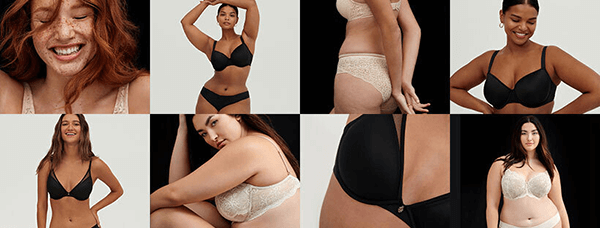
The face of the American consumer is changing — 48% of post-millennials in the US are now nonwhite; and 1 in 6 Gen Z adults identifies as LGBTQ. As the demographics in the United States evolve and change, you might expect to see the same shifts depicted in ads. However, diversity and inclusion in advertisements still falls short of representing the true variety of people and identities found in today’s consumer.
The results of this (potentially unconscious) bias are not only frustrating for marginalized/underrepresented groups, but a major misstep for the brands that fail to depict them in their ads, as well. By excluding people of a variety of races, genders (and more), brands are losing opportunities to be relevant to more diverse audiences and communities. 58% of LGBTQ+ respondents to one survey say that they have stopped buying from a brand because of lack of representation in advertising, while 53% of African Americans have stopped supporting a brand because it didn’t represent their identity.
For example, exclusively depicting heterosexual couples in ads for a wedding planning service or dating app might make LGBTQ+ couples feel that these services or products aren’t meant for them.

By including a diverse range of couples, The Knot, a wedding planning website, is able to signal to potential customers that their product is inclusive and welcoming to same sex couples.
Businesses that are doing D&I right aren’t just promoting more inclusive media, they’re see real business benefits, too. According to a Google analysis, diversity and inclusion in advertising can make a substantial impact in brand sentiment among underrepresented groups. They found that 69% of black consumers were more likely to purchase from a brand that includes positive portrayals of their race/ethnicity. The same study also found that 70% of black millennials say they are more likely to buy from brands that take a stand on race-related issues.
Similarly, they found that 71% LGBTQ+ customers were more likely to trust and interact with digital ads from brands that authentically represent members of the LGBTQ+ community. Even people who do not belong to the LGBTQ+ community look favorably on companies that feature LGBTQ+ people in their advertising. A P&G and GLAAD study showed that, with 68% of Non-LGBTQ+ respondents reporting that seeing LGBTQ people in advertising makes them feel better about buying products from that company.
WITHIN Executive Producer Steen Wichmann has seen momentum recently, “Over the last three or four years there’s been a big call for more inclusion and diversity in projects across the board in advertising and marketing. Once, it was mainly creative agencies pushing for this, but now we see more brands leading those conversations and being proactive about casting diverse talent in their ads.”
Now, when we talk about diversity, it’s not simply about man vs. woman, or black vs. white. Diversity comprises many facets of the human experience. When casting for talent, producers should consider:

Intimates brand ThirdLove has made their mark by portraying themselves as the anti-Victoria’s Secret by casting diverse models across the age, race, and body size spectrum.
With such a wide range of diversity in the world, how can you pick a place to start? One of the best ways to focus your efforts is to understand the diversity that already exists within your own customer base. Gathering and analyzing customer demographic data after purchase or via email can be a great low-cost way to better understand your customers, and the data may surprise you!
Don’t rely solely on your customer personas to dictate the type of people you cast in your ads and marketing campaigns. Adhering too strictly to depictions of who you think your typical customer is may artificially limit your brand’s reach. After seeing your advertisements, would a person of color, or member of the LGBTQ+ community be likely to consider themselves a potential customer? The more people who can see themselves in a brand, the more likely they are to convert.
One of the best ways to gain traction is to intentionally create more authentic content. Steen notes that “authenticity in content, like what is seen in User Generated Content (UGC) on social, definitely has the power to improve performance in an account. Without diversity, things can feel inauthentic.”
So how do you make sure that your content is hitting the authenticity mark? A great place to start is by listening to the diverse voices within your own organization for their thoughts, opinions, and experiences. How would they like to be depicted? What would they like to see?
“Having a diverse and broad perspective throughout the creative process is so important,” Creative Producer Quinn Barker explains. ”Otherwise, if everyone on your team looks the same, it can become an echo chamber.”
Another way to create positive and authentic representations is to stop and consult members of that specific group at large. WITHIN Creative Project Manager Oli Pleydle sees a lot of potential in tapping into influencers who are trusted voices in their own communities.
“Due to the expansion of social media like TikTok and YouTube, there is this explosion of voices that are out there that are able to give perspective that hold weight and also have huge followings of their own,” says Pleydle. “This allows you to pass the conversation to others, let them bring their unique perspective to your audience and platform.”
The focus on Diversity and Inclusion isn’t a fad or a trend; it’s a paradigm shift with staying power. As society puts more emphasis on diversity and demands more inclusion in all areas of life, failing to authentically address the full breadth of your audience in advertising is going to hold your brand back. Diversity and Inclusion is no longer a “nice-to-have,” but a “must-have” going forward. But remember — the goal isn’t merely to check a box, it’s to reach out to show groups that you empathize with them and want to become a brand they trust.
To learn more about crafting effective digital marketing campaigns for your audiences, let’s talk.
Katie is a Demand Generation Manager at WITHIN. A New York native recently relocated to Texas (still getting used to the heat!), she loves nerding out to the latest marketing news and industry trends and is a serial newsletter subscriber.
Get industry insights and news directly to your inbox.
Thank you. Check your email for details on your request.
| Cookie | Duration | Description |
|---|---|---|
| __hssrc | session | This cookie is set by Hubspot whenever it changes the session cookie. The __hssrc cookie set to 1 indicates that the user has restarted the browser, and if the cookie does not exist, it is assumed to be a new session. |
| checkForPermission | 10 minutes | This cookie is set by Beeswax to determine whether the user has accepted the cookie consent box. |
| cookielawinfo-checkbox-advertisement | 1 year | Set by the GDPR Cookie Consent plugin, this cookie is used to record the user consent for the cookies in the "Advertisement" category . |
| cookielawinfo-checkbox-analytics | 11 months | This cookie is set by GDPR Cookie Consent plugin. The cookie is used to store the user consent for the cookies in the category "Analytics". |
| cookielawinfo-checkbox-functional | 11 months | The cookie is set by GDPR cookie consent to record the user consent for the cookies in the category "Functional". |
| cookielawinfo-checkbox-necessary | 11 months | This cookie is set by GDPR Cookie Consent plugin. The cookies is used to store the user consent for the cookies in the category "Necessary". |
| cookielawinfo-checkbox-others | 11 months | This cookie is set by GDPR Cookie Consent plugin. The cookie is used to store the user consent for the cookies in the category "Other. |
| cookielawinfo-checkbox-performance | 11 months | This cookie is set by GDPR Cookie Consent plugin. The cookie is used to store the user consent for the cookies in the category "Performance". |
| CookieLawInfoConsent | 1 year | Records the default button state of the corresponding category & the status of CCPA. It works only in coordination with the primary cookie. |
| elementor | never | This cookie is used by the website's WordPress theme. It allows the website owner to implement or change the website's content in real-time. |
| JSESSIONID | session | The JSESSIONID cookie is used by New Relic to store a session identifier so that New Relic can monitor session counts for an application. |
| viewed_cookie_policy | 11 months | The cookie is set by the GDPR Cookie Consent plugin and is used to store whether or not user has consented to the use of cookies. It does not store any personal data. |
| Cookie | Duration | Description |
|---|---|---|
| __cf_bm | 30 minutes | This cookie, set by Cloudflare, is used to support Cloudflare Bot Management. |
| __hssc | 30 minutes | HubSpot sets this cookie to keep track of sessions and to determine if HubSpot should increment the session number and timestamps in the __hstc cookie. |
| bcookie | 2 years | LinkedIn sets this cookie from LinkedIn share buttons and ad tags to recognize browser ID. |
| bscookie | 2 years | LinkedIn sets this cookie to store performed actions on the website. |
| lang | session | LinkedIn sets this cookie to remember a user's language setting. |
| lidc | 1 day | LinkedIn sets the lidc cookie to facilitate data center selection. |
| UserMatchHistory | 1 month | LinkedIn sets this cookie for LinkedIn Ads ID syncing. |
| Cookie | Duration | Description |
|---|---|---|
| _uetsid | 1 day | Bing Ads sets this cookie to engage with a user that has previously visited the website. |
| _uetvid | 1 year 24 days | Bing Ads sets this cookie to engage with a user that has previously visited the website. |
| Cookie | Duration | Description |
|---|---|---|
| __hstc | 1 year 24 days | This is the main cookie set by Hubspot, for tracking visitors. It contains the domain, initial timestamp (first visit), last timestamp (last visit), current timestamp (this visit), and session number (increments for each subsequent session). |
| __lotl | 5 months 27 days | This cookie is set by Lucky Orange to identify the traffic source URL of the visitor's orginal referrer, if any. |
| _ga | 2 years | The _ga cookie, installed by Google Analytics, calculates visitor, session and campaign data and also keeps track of site usage for the site's analytics report. The cookie stores information anonymously and assigns a randomly generated number to recognize unique visitors. |
| _gcl_au | 3 months | Provided by Google Tag Manager to experiment advertisement efficiency of websites using their services. |
| _gd_session | 4 hours | This cookie is used for collecting information on users visit to the website. It collects data such as total number of visits, average time spent on the website and the pages loaded. |
| _gd_svisitor | 2 years | This cookie is set by the Google Analytics. This cookie is used for tracking the signup commissions via affiliate program. |
| _gd_visitor | 2 years | This cookie is used for collecting information on the users visit such as number of visits, average time spent on the website and the pages loaded for displaying targeted ads. |
| _gid | 1 day | Installed by Google Analytics, _gid cookie stores information on how visitors use a website, while also creating an analytics report of the website's performance. Some of the data that are collected include the number of visitors, their source, and the pages they visit anonymously. |
| _hjAbsoluteSessionInProgress | 30 minutes | Hotjar sets this cookie to detect the first pageview session of a user. This is a True/False flag set by the cookie. |
| _hjFirstSeen | 30 minutes | Hotjar sets this cookie to identify a new user’s first session. It stores a true/false value, indicating whether it was the first time Hotjar saw this user. |
| _hjIncludedInPageviewSample | 2 minutes | Hotjar sets this cookie to know whether a user is included in the data sampling defined by the site's pageview limit. |
| _lo_uid | 2 years | This cookie is set by Lucky Orange as a unique identifier for the visitor. |
| _lo_v | 1 year | This cookie is set by Lucky Orange to show the total number of visitor's visits. |
| _lorid | 10 minutes | This cookie is set by Lucky Orange to identify the ID of the visitors current recording. |
| hubspotutk | 1 year 24 days | HubSpot sets this cookie to keep track of the visitors to the website. This cookie is passed to HubSpot on form submission and used when deduplicating contacts. |
| IR_gbd | session | Impact Radius sets this cookie to store a unique ID which is used to identify the user's device, when they return to the websites that used the same network. |
| Cookie | Duration | Description |
|---|---|---|
| __qca | 1 year 26 days | The __qca cookie is associated with Quantcast. This anonymous data helps us to better understand users' needs and customize the website accordingly. |
| _fbp | 3 months | This cookie is set by Facebook to display advertisements when either on Facebook or on a digital platform powered by Facebook advertising, after visiting the website. |
| _mkto_trk | 2 years | This cookie, provided by Marketo, has information (such as a unique user ID) that is used to track the user's site usage. The cookies set by Marketo are readable only by Marketo. |
| B | 1 year | This Cookie is used by Yahoo to anonymously store data related to user's visits, such as the number of visits, average time spent on the website and what pages have been loaded. This data helps to customize website content to enhance user experience. |
| bito | 1 year 1 month | This cookie is set by Beeswax for advertisement purposes. |
| bitoIsSecure | 1 year 1 month | Beeswax sets this cookie for targeting and advertising. The cookie is used to serve the user with relevant advertisements based on real time bidding. |
| fr | 3 months | Facebook sets this cookie to show relevant advertisements to users by tracking user behaviour across the web, on sites that have Facebook pixel or Facebook social plugin. |
| mc | 1 year 1 month | Quantserve sets the mc cookie to anonymously track user behaviour on the website. |
| MUID | 1 year 24 days | Bing sets this cookie to recognize unique web browsers visiting Microsoft sites. This cookie is used for advertising, site analytics, and other operations. |
| test_cookie | 15 minutes | The test_cookie is set by doubleclick.net and is used to determine if the user's browser supports cookies. |
| tuuid | 2 years | The tuuid cookie, set by BidSwitch, stores an unique ID to determine what adverts the users have seen if they have visited any of the advertiser's websites. The information is used to decide when and how often users will see a certain banner. |
| tuuid_lu | 2 years | This cookie, set by BidSwitch, stores a unique ID to determine what adverts the users have seen while visiting an advertiser's website. This information is then used to understand when and how often users will see a certain banner. |
| Cookie | Duration | Description |
|---|---|---|
| __pdst | 1 year | No description available. |
| _an_uid | 7 days | No description available. |
| _dc_gtm_UA-61749619-1 | 1 minute | No description |
| _dlt | 1 day | No description |
| _hjSession_1771567 | 30 minutes | No description |
| _hjSessionUser_1771567 | 1 year | No description |
| _nx-nocache | session | No description available. |
| 6suuid | 2 years | No description available. |
| A3 | 1 year | No description |
| ABCDEFGHIJKLMNOPQRSTUVWXYZabcdefghijklmnopqrstuvwxyz0123456789+/ | session | No description |
| AnalyticsSyncHistory | 1 month | No description |
| BIGipServerab44web-nginx-app_https | session | No description |
| bounceClientVisit3783c | 30 minutes | No description |
| bounceClientVisit3783v | 30 minutes | No description |
| dgzsdl08v4 | 10 minutes | No description |
| IR_11658 | session | No description |
| li_gc | 2 years | No description |
| tableau_locale | session | No description available. |
| tableau_public_negotiated_locale | session | No description available. |
| test | 1 year | No description available. |